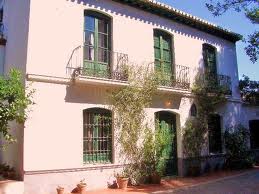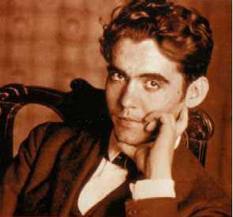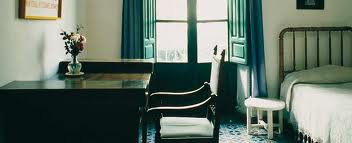Federico Garcia Lorca Museum

Where: Huerta de San Vicente is located in the extreme South-East of Granada, inside then Federico García Lorca Park, between the motorway and Calle Arabial, 10 minutes away from the city centre.
Opening hours:
Mornings: July to August from 10 am to 2.30 pm, September to June from 10 am to 12.30 pm
Afternoons: October to March from 4 pm to 6.30 pm and April to September from 5 pm to 7.30 pm
*Visits to the Federico García Lorca House-Museum are guided, once they begin they cannot be interrupted. Only 15 people are admitted at the same time inside the house. Federico García Lorca the most important Spanish writers and of paramount importance to the country's culture. If you ever take Spanish courses in Granada it is very likely that you'll get acquainted with his poetry.
Any Granada travel guide will tell you it is a must activity in Granada.
Federico García Lorca
Born in Fuente Vaqueros, Granada in 1898, García Lorca counts among the most noted Spanish playwrights and poets. During his first years he lived in the rural environment of his home town, and from a very early age he showed talent for learning popular songs. He was a sickly child and didn't walk until he was four. At home he read the works of Victor Hugo and Miguel de Cervantes, though he was rather irregular at school.
He studied Law in the Law Faculty of the University of Granada though he never pursued a career in law, as his true passion was literature.
The south of Spain was where the live Moorish heritage was most present –folklore, orient and an wild geography...all of these made and imprint on García Lorca, which is captured in his work. After his mother, it was Fernando de los Ríos who stimulated the artist in favour of poetry. García Lorca was then a pianist.

The Spain of García Lorca's time corresponds to the Silver Age, with a rich intellectual life dominated by the likes of Benito Pérez Galdós, Miguel de Unamuno, José Ortega y Gasset and Salvador de Madariaga, all of them writers who criticized the Spanish reality.
García Lorca's first book was published in 1918 Impresiones y Paisajes ('Impressions and Landscapes'), financed by his father. Two years later, his first play The Butterfly's Evil Spell premiered. The following years were prolific; he wrote books and plays, and even exhibited his paintings in Barcelona. He also visited the Spanish poets from his generation and other artists such as Buñuel and Salvador Dalí, to whom he dedicated the work 'Ode to Salvador Dalí'.
In 1929 he traveled to New York, then to Havana and finally back to Spain. When the Second Republic in Spain was established, his friend Fernando de los Ríos was named Minister of Public Education, and under official sponsorship, Lorca was given the co-direction of the state theatre company 'La Barraca', where he had access to all the necessary resources to write, direct, produce and adapt some plays from the Spanish Golden Age. During this period he wrote Blood Wedding and Yerma (which in Spanish means barren).
Between 1933 and 1936 García Lorca wrote The House of Bernarda Alba and was working in The Destruction of Sodom when the Spanish Civil War broke out.
The ambassadors of Colombia and Mexico both could foresee that the poet would be a victim of the war due to his position in the government and offered to give him refuge in their respective countries, however, García Lorca refused and instead traveled to his hometown in Granada to spend the summer.
It is said that someone asked him how he felt in regards to his political preferences and that he replied he felt ever more Catholic, communist, anarchist, traditionalist, libertarian and monarchic. Lorca in fact never became affiliated to any political party and he never discriminated and became estranged from any of his friends because of their political believes. Sadly, that wasn't enough.
After an anonymous whistle blower informed the police of his whereabouts, García Lorca was arrested at one of his friends' house, the poet Luis Rosales, on the 16th of August, 1936. Rosales obtained the promise from the national authorities that Lorca would be freed as long as there was no 'charges were pressed against them'. The execution order was given by Granada's civil governor José Valdés Guzmán, the same person who had ordered his arrest.
The latest investigations have determined that Federico García Lorca was executed on the 18th of August, 1936, probably because of territorial issues, since some conservative landowners resented García Lorca's father because he was much more progressive. However, there are more reasons: He was a republican and a homosexual – unforgivable crimes in Spain in the 1930s.
The House Museum

La Huerta de San Vicente was opened as a set of furniture, paintings and belongings that were in the house when the City Hall purchased the property. The only reliable documents about the arrangement of the house were a series of photographs taken between 1926 and 1936. Those photographs have served as guidelines to arrange and restore the furniture that currently conforms the space of the house-museum. An enchanting place to see when you visit Spain.
In it, we can see the poet's desk, gramophone, baby grand piano, chaise-longue, the reproduction of Botticelli's Triumph of Spring, the art deco framed mirror, among many other things. Besides the pictures, the testimony of people who lived in Huerta de San Vicente has been of utmost importance, specially that of Isabel García Lorca and Vicenta and Manuel Fernández Montesinos (the poet's sister and her niece and nephew).
The rest of the furniture, belonging and works of art that can be seen in the house-museum either were part of the furniture of Huerta de San Vicente at some point or other between 1926 and 1936, or they belonged to the Lorca family. So the house-museum does not conceal the fictional elements: the house is not exactly as it was when inhabited by Federico García Lorca, however, it is the closest approximation we can possibly get. It assumes the inevitable tension between the scientific and the touristic, between memory and myth, and attempts to offer a better knowledge of the life and work of one of Spain's finest poets.
A place of artistic and literary memory, as well as a place of residence and creation (1926-1936), the Federico García Lorca House Museum allows to remember and understand aspects such as:
- Ambience and decoration of a Granada rural house of the beginning of the 20th century
- Concrete elements of the daily life of the García Lorca family
- The works written by García Lorca in Huerta de San Vicente
- The poet's friendships and artistic relations, related to the collection exhibited in the house museum (artwork, objects, etc.)
- Landscape and emotional relations between Huerta de San Vicente and the city, through the poet's perspective and work.
- The events that took place between July 14 and August 9, 1936.
In short, the house-museum, if not 100% accurate, tries to give an approximate representation of a man that was and is so important to Spanish culture, by somehow seeing through his own eyes, as the visitor witnesses the kind of life García Lorca had and loved.



